When I first heard the news
On BBC.com one afternoon in June, 2016
It was like for a moment The Whole World Stood Still
In paying respect to an Iconic Sportsman
A young Olympian boxer
Who grew in strength and stature
Deservingly earning the world title as "The Greatest"
To Desi, Muhammad Ali, born Cassius Clay
Is truly The Universal Man
He's American, yet the whole world
Deem and adore him as one of their flock
Because he was a Unique
One of the Human Kind
Because he was indeed, Human and Kind.
Now he's seated at that special corner
Of the Ring up there, one of selected guardians
Of the Kingdom that trancends race, religion and age
For Muhammad Ali is a humble yet elevated representatve Of the Human Race
May He Rest in PeAce and Glory
And be our guide for GOoDness that the species called Homo Sapiens can at least aspire
To live up to the glorious path
Paved with spiking stones and hard knocks of transient Life
Endured and smoothened by him
Walking the Quest before us
We all agree He Was In Deed The GREaTEST.
******************************
From bbc.com:~~~~~~~
Boxing legend Muhammad Ali dies at 74
- 4 June 2016
- From the section US & Canada
Boxing legend Muhammad Ali - one of the world's greatest sporting figures - has died at the age of 74.
The
former world heavyweight champion died late on Friday at a hospital in
the US city of Phoenix, Arizona, having been admitted on Thursday.He had been suffering from a respiratory illness, a condition that was complicated by Parkinson's disease.
Ali's funeral will take place in his hometown of Louisville, Kentucky, said his family.
Latest updates and tributes
Obituary: Muhammad Ali
Muhammad Ali in his own words
Latest tributes
Nick Bryant: How Ali changed his sport and country
Foreman: "One of the greatest human beings"
Tributes for the heavyweight great have been pouring in from across the world.
"Muhammad Ali shook up the world. And the world is better for it," said US President Barack Obama and his wife Michelle.
Former President Bill Clinton - husband of Democratic frontrunner Hillary - said the boxer had been "courageous in the ring, inspiring to the young, compassionate to those in need, and strong and good-humoured in bearing the burden of his own health challenges".
Republican presumptive presidential nominee Donald Trump, meanwhile, tweeted that Ali was "truly great champion and a wonderful guy. He will be missed by all!"
Muhammad Ali
Born Cassius Marcellus Clay, 17 January 1942
61 fights
over a professional career lasting 21 years
56 wins
including 37 knockouts-
3 times crowned World Heavyweight Champion
-
1 Light-heavyweight Olympic gold medal
-
31 straight wins before being beaten by Joe Frazier
Getty
American civil rights campaigner Jesse Jackson said Ali had been willing to sacrifice the crown and money for his principles when he refused to serve in the Vietnam war.
Born Cassius Marcellus Clay, Ali shot to fame by winning light-heavyweight gold at the 1960 Rome Olympics.
Nicknamed "The Greatest", the American beat Sonny Liston in 1964 to win his first world title and became the first boxer to capture a world heavyweight title on three separate occasions.
He eventually retired in 1981, having won 56 of his 61 fights.
How great was he?
Muhammad Ali timeline
Online tributes to Ali
Crowned "Sportsman of the Century" by Sports Illustrated and "Sports Personality of the Century" by the BBC, Ali was noted for his pre- and post-fight talk and bold fight predictions just as much as his boxing skills inside the ring.
But he was also a civil rights campaigner and poet who transcended the bounds of sport, race and nationality.
Asked how he would like to be remembered, he once said: "As a man who never sold out his people. But if that's too much, then just a good boxer.
"I won't even mind if you don't mention how pretty I was."
British champion Henry Cooper came close to stopping Clay, as he was still known, when they met in a non-title bout in London in 1963.
Cooper floored the American with a left hook, but Clay picked himself up off the canvas and won the fight in the next round when a severe cut around Cooper's left eye forced the Englishman to retire.
At the scene: Jessica Lussenhop, BBC News, Louisville, Kentucky
"I wouldn't have thought he'd go that quick," says Kevin Ishmael, a saw operator who laid a bouquet of daffodils at the Muhammad Ali Center, an expansive museum on the waterfront in downtown Louisville.
The news of his death is on every local television station, and the front page of the local newspaper reads simply "The Greatest" over the iconic image of Ali standing victorious over Sonny Liston in 1965.
Flags at Louisville's city hall will fly at half mast today and the mayor will deliver a memorial service there.
"I cried. I cried like a baby when I found out the news," says Arnold Mathis, 39, who was on his way to lay a wreath and light a candle at the museum. "It's so surreal. I know he's dead, but it hasn't really set in yet."
Almost everyone has a personal story about Ali, whether it's a favourite fight, a glance through a car window, or a trip to his boyhood home, which opened as a museum only last week, the interior recreated as if Ali were still living there as a precocious 12-year-old boy in the 1950s.
Dwight Smith, who was sweeping the empty downtown streets outside the hotel where he works, doesn't remember the day Ali hoisted him up for photos - he was only a baby - but he uses them as a motivator to this day.
"A great man held me high," he said. "Go for what you want. If you dream it, you can achieve it. That was one of his mottos.
"I'm just hoping we get a really nice statue of him."
Read more from Jessica
In February the following year, Clay stunned the boxing world by winning his first world heavyweight title at the age of 22.
He predicted he would beat Liston, who had never lost, but few believed he could do it.
Yet, after six stunning rounds, Liston quit on his stool, unable to cope with his brash, young opponent.
But in contrast to the inclusive approach favoured by civil rights leaders like Dr Martin Luther King, the Nation of Islam called for separate black development and was treated by suspicion by the American public.
Ali eventually converted to Islam, ditching what he perceived was his "slave name" and becoming Cassius X and then Muhammad Ali.
Tributes to Ali
"Muhammad Ali was one of the greatest human beings I have ever met. No doubt he was one of the best people to have lived in this day and age." - George Foreman, Ali's friend and rival in the Rumble in the Jungle
"There will never be another Muhammad Ali. The black community all around the world, black people all around the world, needed him. He was the voice for us. He's the voice for me to be where I'm at today." - Floyd Mayweather, world champion boxer across five divisions
How world remembers Ali
World media: Muhammad Ali was unique
In 1967, Ali took the momentous decision of opposing the US war in Vietnam, a move that was widely criticised by his fellow Americans.
He refused to be drafted into the US military and was subsequently stripped of his world title and boxing licence. He would not fight again for nearly four years.
After his conviction for refusing the draft was overturned in 1971, Ali returned to the ring and fought in three of the most iconic contests in boxing history, helping restore his reputation with the public.
He was handed his first professional defeat by Joe Frazier in the "Fight of the Century" in New York on 8 March 1971, only to regain his title with an eighth-round knockout of George Foreman in the "Rumble in the Jungle" in Kinshasa, Zaire (now Democratic Republic of Congo) on 30 October 1974.
Six defences of his title followed before Ali lost on points to Leon Spinks in February 1978, although he regained the world title by the end of the year, avenging his defeat at the hands of the 1976 Olympic light-heavyweight champion.
Ali's career ended with one-sided defeats by Larry Holmes in 1980 and Trevor Berbick in 1981, many thinking he should have retired long before.
He fought a total of 61 times as a professional, losing five times and winning 37 bouts by knockout.
Parkinson's Syndrome was eventually diagnosed but Ali continued to make public appearances, receiving warm welcomes wherever he travelled.
He lit the Olympic cauldron at the 1996 Games in Atlanta and carried the Olympic flag at the opening ceremony for the 2012 Games in London.
How Ali wanted people to remember him
"I would like to be remembered as a man who won the heavyweight title three times, who was humorous and who treated everyone right."As a man who never looked down on those who looked up to him...who stood up for his beliefs...who tried to unite all humankind through faith and love.
"And if all that's too much, then I guess I'd settle for being remembered only as a great boxer who became a leader and a champion of his people. And I wouldn't even mind if folks forgot how pretty I was."
*******************************************************
From theguardian.com:~~~~~~
Our picture editor has selected his favourite photographs of Muhammad
Ali from the archives. The selection includes pictures of some of the
most memorable fights as well as distinctive portraits from his life
outside the ring
-
Muhammad Ali was never shy about lauding his own balletic talents in the boxing ring, and this photograph shows why. His ability to move away from his opponent, Joe Frazier, with such grace makes Frazier’s haymaker look utterly crude. Ali appears to be untouchable. How ironic, then, that Frazier won the contest that was dubbed Fight of The Century.Photograph: Bettmann/Corbis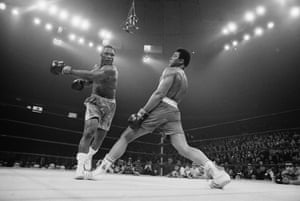
-
This photograph was taken ahead of the world title fight in 1971. Frazier is steadfastly trying to ignore his bitter rival but in fact you wonder if he’s imprisoned by Ali’s taunts – a feeling that’s reinforced by the wire meshing which separates the two men. I also love how their eyes don’t meet; it fills the frame with tension.Photograph: John Shearer/Time & Life Pictures/Getty Image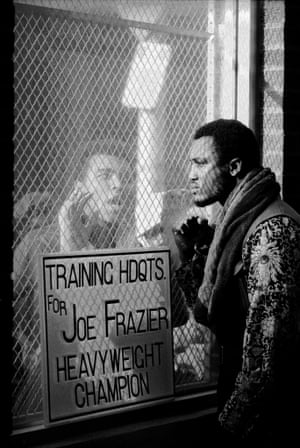
-
Ali was still known as Cassius Clay when this photo was taken. There’s something boyish about his efforts to impress his audience. I like how one of the women, Ronnie Spector, seems impervious to his bravado. I also like knowing that the guy in the white tuxedo, who is neither overawed nor overshadowed by Clay, is a young Stevie Wonder.Photograph: Redferns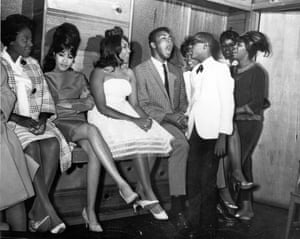
-
This brutal photo of Leon Spinks’ contorted face communicates the power of Ali’s punch. Ali’s expression is also compelling – he looks somewhat savage. Technically the framing is awkward. I would prefer it if Spink’s face weren’t at the very edge of the frame, but it’s hard to grumble with such a visceral shot.Photograph: Dirck Halstead/Getty Images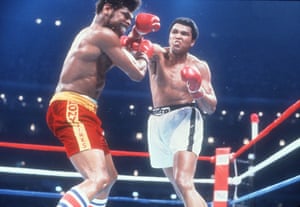
-
-
A quick and homespun piece of showmanship which made for a striking photograph. Ali had been accused of being a loud-mouth for always predicting when he would beat his opponents. He needed no words and just two props to fashion a comic response to such criticism.Photograph: Bob Thomas/Getty Images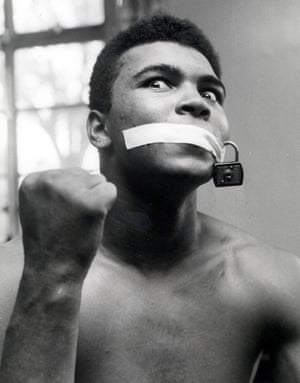
-
This is a scene from a party after Clay beat Sonny Liston for the heavyweight title. Such is the power of his celebrity, the assembled crowd are jostling around him simply to watch him eat. The proximity of Malcolm X to Clay serves as a neat metaphor for the closeness of their relationship at that time.Photograph: Bob Gomel/The LIFE Images Collection/Getty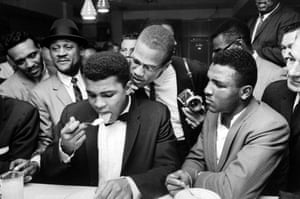
-
This is a great story more so than a great image, but it’s still well worth a mention. Ali had been passing a high-rise building in 1981 when he noticed a commotion; a man was threatening to commit suicide by jumping from the ninth floor. Ali asked the police officers if he could help and duly coaxed the troubled man down from the ledge.Photograph: Bettmann/Corbis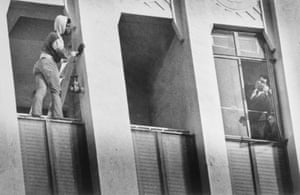
-
Gordon Parks’ shot of Ali after a training session in Miami in 1966 is breathtaking. So much detail, so much contrast and, for once, it’s a portrait of the champion without any hint of braggadocio.Photograph: Gordon Parks/AP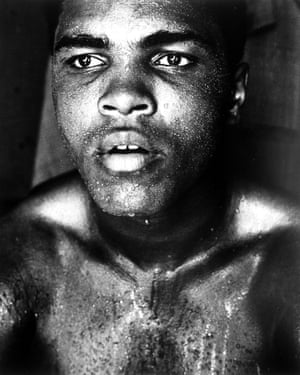
-
-
Clay was just 18 when he won Olympic gold in 1960 in the light heavyweight category. Just look how callow he appears, particularly in comparison to the guys to his left and right, who look like 40-year-old bricklayers in comparison.Photograph: Central Press/Getty Images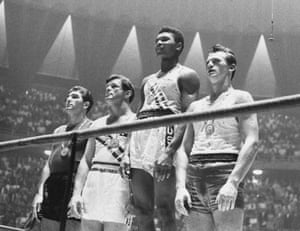
-
The expressions, the simmering contempt, the outfits, the saturated colours – what’s not to love about this image of Ali and George Foreman taken before Ali’s second fight with Jerry Quarry?Photograph: Neil Leifer/Sports Illustrated/Getty Images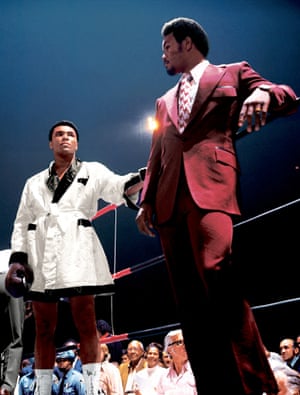
-
In all of the photographs I’ve seen of Ali, I can’t think of any where he looks as supremely toned as this. You can almost see the sinews of his upper body tensing as he prepares to unload a punch. The unusual patchwork of the background lighting, which seems to hang above the ring, is pretty electrifying as well.Photograph: Allsport/Getty Images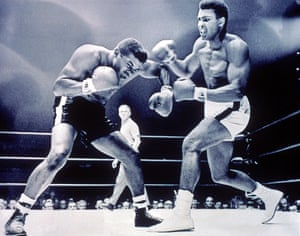
-
The initial attraction to this shot is, of course, the quirk of the punchbag. It appears semi-transparent because the photographer has used flash to trap the action in the foreground, while the duration of the overall exposure has rendered the background visible as well. The beautiful silhouettes in the distance behind Ali are critical too.Photograph: Jess Tan/AP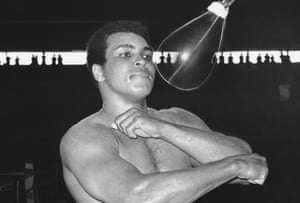
-
The perspective of this shot is what makes it work for me. Ali is towering over the photographer, dominating him with his physical presence as well as his verbal tirade. From any other angle this just wouldn’t have the same impact.Photograph: Harry Benson/Hulton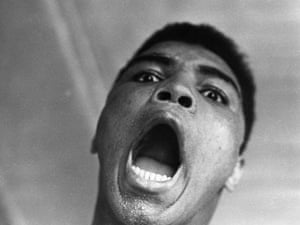
-
One of the most celebrated magazine front covers of all time and understandably so. Carl Fischer’s shot for Esquire was the brainchild of art director George Lois. The reference to St Sebastian speaks of Ali’s persecution following his refusal to fight in the Vietnam war. Sticking the arrows on to Ali’s body was a nightmare, Fischer told me; the arrows had to be strung up using fishing wire because they kept falling down.Photograph: Carl Fischer/Esquire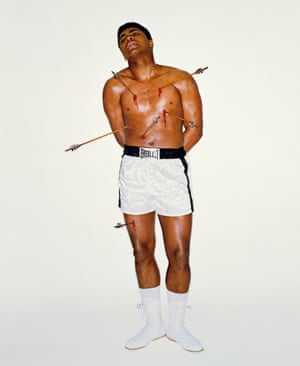
-
In dumping George Foreman to the canvas in ‘The Rumble in the Jungle’, Ali reclaimed the heavyweight title after his long suspension for refusing to be drafted into the US Army. Admittedly boxers never look pretty when they’re going down, but Foreman looks like a giant tree that’s been felled.Photograph: RED/AP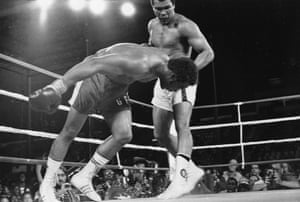
-
The version of this photograph which made the cover of Sports Illustrated was shot by Richard Meek. But I prefer this picture taken shortly beforehand by Ali’s friend Howard Bingham. It’s just a little more fun. And I like how the security guard is there in the background keeping tabs.Photograph: Howard Bingham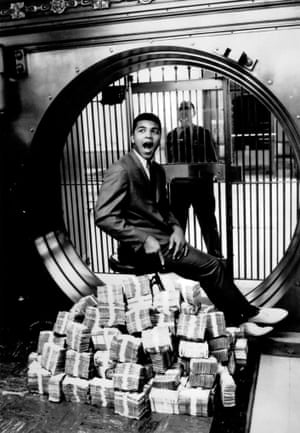
-
Ali’s distinctive footwork – the so-called ‘Ali shuffle’ – is rendered cleverly here using multiple exposures. The effect recalls Eadweard Muybridge’s early stop-motion experiments on horses in Palo Alto in the 1870s and his later studies of human models.Photograph: Neil Leifer/Sports Illustrated/Getty Images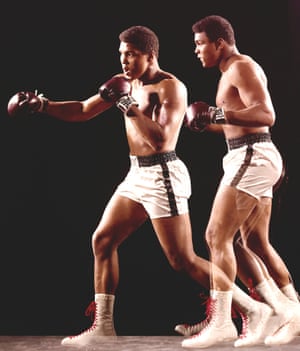
-
Ali’s capacity to engage with the camera and project himself was extraordinary. A shot like this has the power to make you feel like you’re there in the back of the cab with him. It’s an incidental point, but I also love the car’s interior and the way it frames the shot.Photograph: James Drake/Time & Life Pictures/Getty Image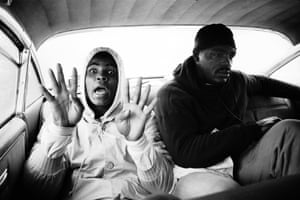
-
The juxtaposition between these two figures is great. Even when hunched over, Ali still dwarfs the comedian and singer Sammy Davis Jr, whom he’s teaching how to box. More than that, though, it’s the kind of photograph which attests to Ali’s character and charm outside the ring.Photograph: Bettmann/Corbis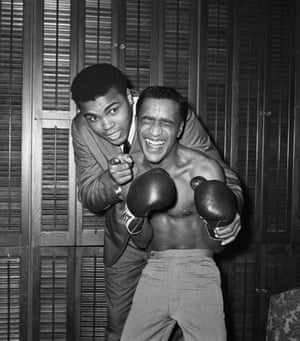
-
The most famous photo of Ali ever taken is of him standing over Sonny Liston, who appeared to have thrown their 1965 bout. It was taken by Neil Leifer and was shot in colour. Spare a thought then for John Rooney, sat right beside Leifer, who captured this less-acclaimed version. Growing up, I remember buying this one and loving it all the same.Photograph: John Rooney/Associated Press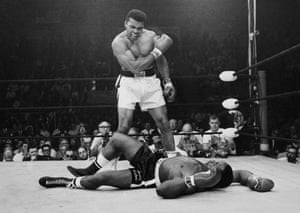
-
Ali was 34 by the time this photograph was taken of him and Ken Norton playfully chasing one another across the field at Yankee Stadium. You don’t get fight promotions like this these days. Also, as my colleague pointed out, look at their shoes – what on earth are they wearing those Cuban heels for?!Photograph: Bettmann/CORBIS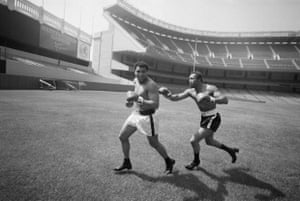
-
I find this image of Ali and Frazier, taken in 2003, to be profoundly melancholic . These two men, who were once so supreme and who shared such a glorious history, appear to have been defeated by age – Frazier especially. It’s an uncomfortably earnest portrait.Photograph: Walter Iooss Jr./SPORTS ILLUSTRA/Sports Illustrated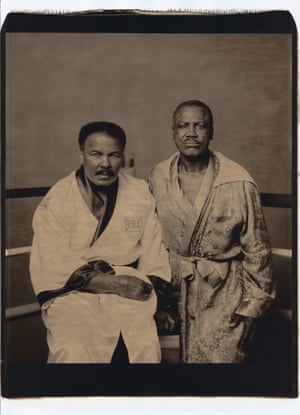
-
This shot witnesses a pre-fight scene where Ali is poised with anticipation. His outline is so distinctive – it reminds me of the famed image of Ali underwater by Flip Schulke. Notice, also, the shadowy figure in the toilet behind Ali; at first I questioned whether he spoiled Ali’s solitude, but I grew to like the subtle detail of their twinning.Photograph: James Drake/The LIFE Picture Collection/Gett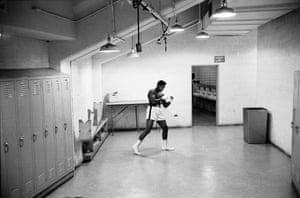
-
This emotive picture was snapped when Clay beat Liston, who was unable to answer the bell for round seven of their 1964 fight. There are many fine photos of this moment taken head on but in this one I like Clay’s explosive pose and the way his cartwheeling limbs extend towards the corners of the frame. It’s as if he’s about to leap out of it.Photograph: Photoshot/Getty Images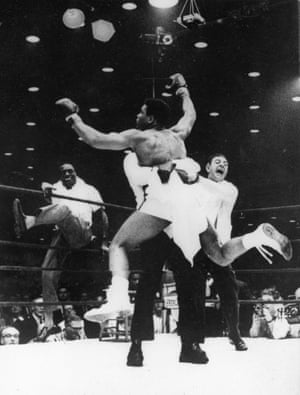
-
In 2003 this was voted the greatest sport photo ever by the Observer. Even Neil Leifer calls it his best shot – one, he says, on which he cannot improve. He’s right. The pristine white canvas is the perfect backdrop, accentuating the two fighters whose figures are so neatly counterposed. I can’t imagine boxing will ever look this sublime again.Photograph: Neil Leifer/Sports Illustrated/Getty Images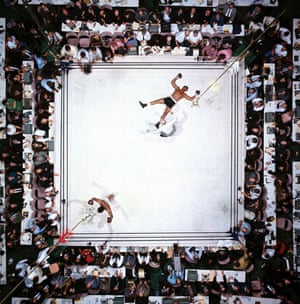
more galleries

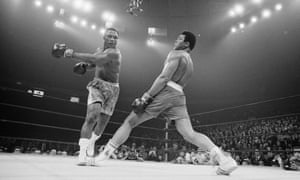
No comments:
Post a Comment